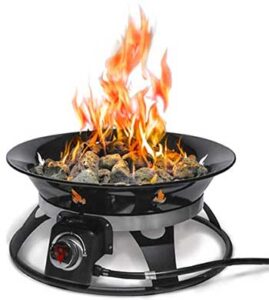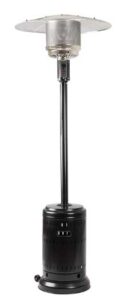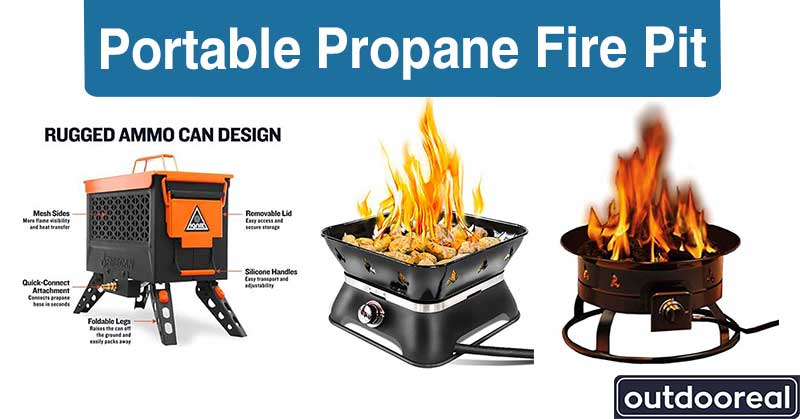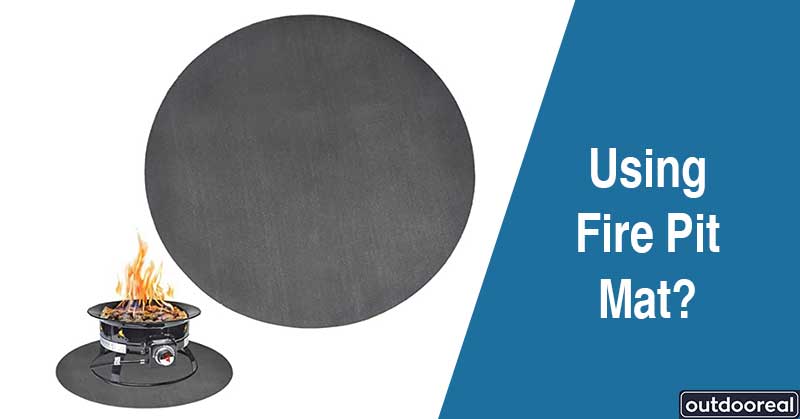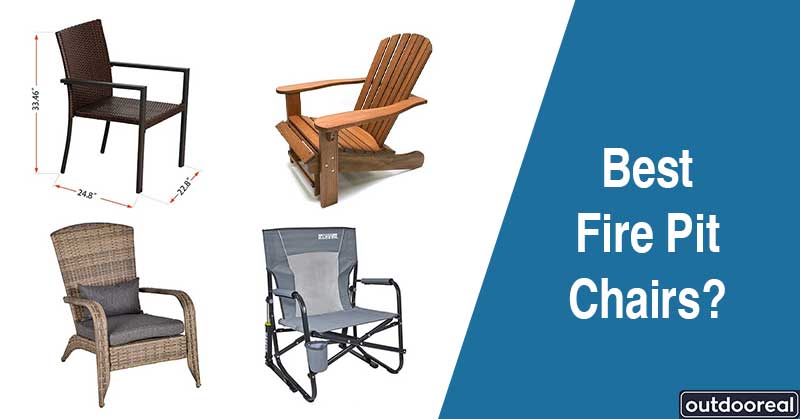Patio heaters and fire pits can be the best heating solutions for particular needs and situations. In contrast to patio heaters, fire pits feature an open & bold flame. While selecting between fire pits and patio heaters, you should consider area temperature, safety, price, ease of usage, and operating location.
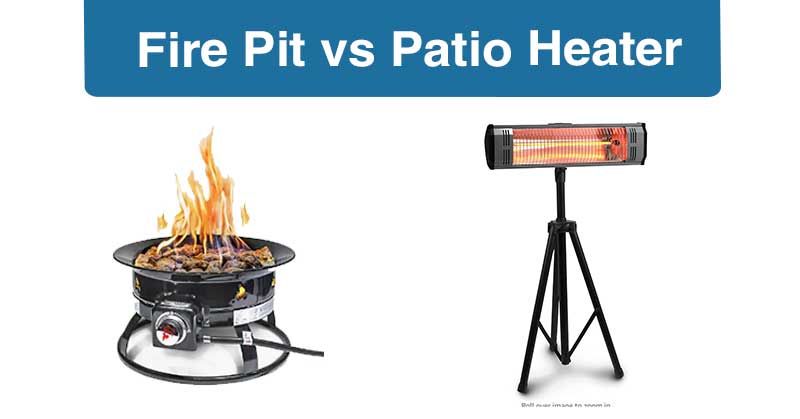
In this article, you will get systematically arranged information and facts on fire pit or patio heater safety, their features, usage, and comparisons to help you decide on the ideal product.
Main Differences Between Fire Pit and Patio Heater
Topic | Fire Pit | Patio Heater |
Heat output | 30,000 to 100,000 BTUs | 20,000 to 50,000 BTUs |
Safety |
| Considerably safer than other outdoor heating appliances( especially electric patio heaters) |
Types | Gas and electric types. | |
Portability | Limited portability with portable fire pits and zero portability for fixed fire pits. | It has good portability if it’s a propane patio heater; electric patio heaters have limited portability, except for natural gas heaters. |
Ease of use & maintenance | It requires exhaustive maintenance and cleaning; however effortless to use. | Simple maintenance and straightforward ways of using them are available, though gas patio heaters can be difficult to use sometimes. |
Operation cost | Affordable | Affordable |
Product Price | Affordable | Little bit costly |
Location | Only outdoors and no porch. | Outdoor and covered porch-friendly. |
Aesthetics | Adds more ambiance and charm to the backyard. | Ideal for commercial settings but less suitable for use at home. |
Longevity | 10-15 years or more. | 3-6 years. |
Cooking | Perfect for BBQ, pot cooking, and grilling. | Prohibited. |
Weather resistance | Moderate weather resistance except for sudden gusts of winds. | Little weather resistance, especially in strong winds and snow. |
Differences in Details
Heat- output
When it comes to heat amount, the fire pit will always win over the patio heater, as it runs on natural fuel and has an open flame. Fire pit usually produces from 30,000 BTUs up to 100,000 BTUs, which is perfect for people living in colder regions. In contrast, patio heaters can provide up to 50,000 BTUs if it’s gas-fueled heaters; for electric styles, it’s a maximum of 3000 watts. If you use a patio heater outside, you may need two or more heaters to warm the area adequately.
Safety
Whether gas-run or electric, patio heaters are always the best options for safe operations. Most market-dominating heaters include auto-shut systems, and due to their closed nature, they have a meager chance to spark or ember flying out. Also, if the hose gets a leak, patio heaters have the thermocouple to auto-shutoff the system. However, fire pits have open flames, making them most alluring yet dangerous. Flying embers or sparks can cause an accident if the safety distance is not cleared correctly. Though, many people use spark screens and protective heat pads to reduce the chances of fire risks.
Types
Fire pits are mainly three types; wood-burning, propane, and gas patio heater. And apart from the fuel-based classification, they also have fixed and portable types. For example, natural gas-run fire pits are permanently fixed, while wood-burning and propane can be fixed or mobile.
Patio heaters do come in a lot of styles and shapes. They are mainly propane, gas, and electric types based on fuel. And about the classes, patio heaters can be standing, mushroom-head, wall-mounted, tabletop, ceiling hanged, projection, etc. styles.
Portability
Fire pits provide little portability as they tend to be more extensive and structure-heavy. However, many wood-burning fire pits and propane ones offer enough mobility for taking the fire pit in camping or adventures. For chilly weather, portable wood-burning fire pits are the best option in camps, picnics, tours, and experiences.
Among Patio heaters, propane types provide excellent performance when it comes to portability. Usually, propane patio heaters have wheels under them, allowing you to use them in multiple places. Specifically, electric types provide limited portability due to the electric connection, and natural gas styles are fixed.
Ease of Use & Maintenance
A patio heater is more effortless to maintain and use than a fire pit. Fire pits require extensive maintenance when it is wood-burning ones, as the ashes built up can cause different malfunctions. In comparison, propane or gas fire pits are very simple to maintain.
Patio heaters are very easy to clean and maintain. However, the most surprising part is that remote controls, android devices, etc., can easily control them.
Operation Cost
Both fire pit and patio heaters are affordable to operate; however, deciding between the prices requires remembering the result they put in. A fire pit provides more than 50,000 BTU and requires wood, charcoal, or natural gas. Wood and charcoal are primarily affordable for people living in chilly areas in the states. And natural gas is the cheapest option, be it a fire pit or patio heater. At the same time, propane can be expensive for the patio heater and fire pit, though it lasts more than gas.
Finally, electric patio heaters are the most expensive ones to run, as they provide low BTUs, and you’ll need more than two or three if your home is in a colder region. However, an infrared electric patio heater is efficient of all and ensures radiant heating around the area.
Product Price
Patio heaters are expensive regarding home heating options. Fire pits’ prices start from 50$ and can be up to 700$ or more, and you can even build your own DIY fire pit in the backyard. In contrast, patio heaters will range from 120$ to 800$ or above.
Location and health issues
For use outdoors and under a gazebo, pergola, or covered porch electric patio heater suits best. The fire pit or gas patio heaters can only be used in protected places with safety clearances. The burning of wood or gas causes the fire to produce toxic carbon monoxide and harmful gases. Consuming in an area filled with carbon monoxide may lead to respiratory diseases. Carbon monoxide poisoning can cause death and fatal health problems for asthma patients.
Electric patio heaters are okay with enjoying under-covered porches, gazebos, balconies, garages, or pergolas. They do not produce any harmful gases or smoke.
Aesthetics
The outdoor patio or backyard fire pit creates the most ambient situation. Fire pits usually have rustic designs, including geometric or luxury styles, making them the center of the chill zone while perfectly vibing with the outdoor environment.
Outdoor Patio heaters are more suited for commercial spaces, such as restaurants, street cafes, storefront eateries, etc. However, mushroom-head patio heaters can give the backyard some royal post-lamp beauties. Also, hanging lamp heaters create an excellent vision of the covered porches.
Longevity
The fire pit has the longest life span compared to patio heaters and other home heating accessories. Patio heaters usually last up to 3-5 years and some even more, while fire pits tend to be fit from 4- 15 years and sometimes up to 30 years! And the secret is you can permanently repair a fire pit, whether rusted or broken.
Cooking
People who enjoy having nice s’mores or hot barbecues should go for fire pits. As the fire pit introduces open flame, dutch oven cooking, grilling, barbecue, etc., are accessible as a cinch.
However, cooking is impossible and prohibited with patio heaters.
Weather resistance
Fire pits have strong wind resistance and minimal risk of tipping over and causing a fire. However, the flying embers and sparks make them very dangerous when faced with a gust of wind. In addition, they are vulnerable to rain and snow, causing rust all over the fire pits body, as you’ll have to clean them, which is very tiresome.
Patio heaters are resistant to rain and snow but should be kept in open spaces for a short time. Compared to fire pits, patio heaters have low wind resistance and most easily tip over. Therefore, you should always use a cover, whether a patio heater or a fire pit.
Which One Should I Buy?
You should use a patio heater if:
- Safety is your priority
- You have people with asthma or other respiratory diseases at your home.
- You live in a warm region.
- Maintenance and cleaning are a hassle for you
- You do not live in a strong-wind zone.
- Your budget is expandable.
- The locations you plan to use the heating appliances are under covered porches, gazebos, pergolas, commercial outdoors, or smaller outdoors.
You should use a fire pit if:
- You live in chilly or icy areas where it quickly gets around freezing points.
- Your home has a lovely outdoor backyard and highly ventilated places
- You love to go camping and have fun adventures.
- Maintenance and cleaning are your things
- Firewoods are easily accessible in your areas
- Often, guests or friends visit your house and are treated in the backyard
- You have a big family, and everyone enjoys outdoor sessions.
Final Verdict/Summary
To sum up, patio heaters and fire pits both have pros and cons, making them perfect for different situations and not suited for unique cases. For example, patio heater specializes in safety, ease of usage, maintenance, safe health, portability, and semi-indoor locations. In contrast, a fire pit is best for generous heat output, cooking, cost, weather resistance, and longevity. Therefore, you need to assess the requirements and choose the best ones that ideally satisfy your needs.

